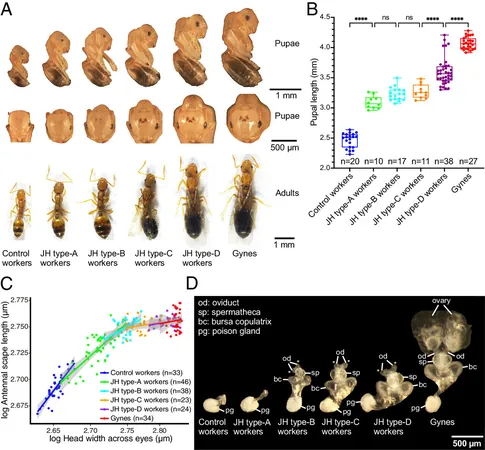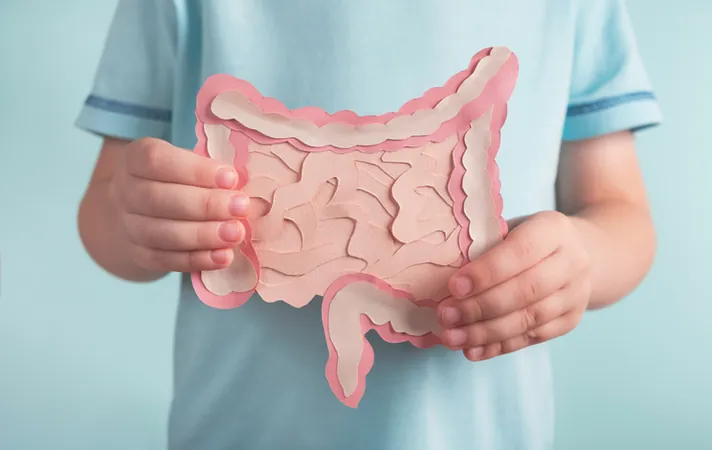
Revolutionary Discovery: How a Hormone Determines Ant Caste and What This Means for Evolution!
2024-11-22
Author: Charlotte
Groundbreaking Discovery in Ant Caste Differentiation
In a groundbreaking study published in the Proceedings of the National Academy of Sciences, researchers from the University of Copenhagen have unveiled the pivotal role of a specific hormone in regulating caste differentiation among ants. This research, titled "Juvenile hormone as a key regulator for asymmetric caste differentiation in ants," provides a significant leap in our understanding of how ant societies function and evolve.
Understanding Ant Social Structure
Ants exemplify fascinating social structures, typically featuring two primary castes: queens and workers. Queens are specialized for reproduction, possessing larger body sizes, wings, three-dimensional frontal eyes, vast ovaries, and specialized organs for sperm storage. Workers, on the other hand, are wingless females characterized by smaller body sizes and diminished reproductive capabilities, usually devoid of sperm storage organs.
William Morton Wheeler, an American entomologist, likened ant colonies to a higher organizational form of life, where queens and workers function analogously to germline and somatic cells in higher animals. This fascinating analogy leads to important questions about how ants can maintain such distinct roles throughout their life cycles.
Hormonal Influence on Caste Development
While in most social insects, caste determination occurs early in the larval stage and can be reversed hormonally, this new study sheds light on how certain ant species, specifically pharaoh ants (Monomorium pharaonis), possess a remarkable ability to flip this script. Through controlled experiments, researchers fed 237 pharaoh ant worker larvae juvenile hormone (JH) analogs during their final larval stage.
The results were astonishing: worker ants exposed to juvenile hormone treatment developed multiple gyne-like traits, including increased body length, new frontal eyes, and even wings and flight muscles! They also exhibited gyne-specific features like a sperm storage organ. However, the study revealed that, unlike their naturally developed counterparts, these hormone-treated individuals did not develop ovaries, reinforcing the idea that the caste differentiation induced by JH sensitivity is tightly regulated and stage-dependent.
Implications for Evolution and Social Structures
Furthermore, the researchers propose that this newfound understanding of JH sensitivity might illuminate the origins of additional castes in different ant species, like soldiers or specialized wingless gynes. These new castes frequently emerge as unique hybrids that blend characteristics of queens and workers—a transformation that can become permanent once natural selection incentivizes certain adaptations.
As we continue to explore the complexity of ant societies, this research opens the door to possibilities regarding how hormonal control mediates not only development within an individual but also broader evolutionary patterns within species. The implications for our understanding of social behavior and evolution in other social organisms could be profound.
Conclusion
This research not only deepens our understanding of ant biology but also raises new questions about the evolution of social structures in the animal kingdom. The delicate balance between hormones, environment, and evolutionary pressure is proving to be a key area of study that could transform our perceptions of life in complex ecosystems. Stay tuned as we uncover more about the intriguing lives of ants!









 Brasil (PT)
Brasil (PT)
 Canada (EN)
Canada (EN)
 Chile (ES)
Chile (ES)
 España (ES)
España (ES)
 France (FR)
France (FR)
 Hong Kong (EN)
Hong Kong (EN)
 Italia (IT)
Italia (IT)
 日本 (JA)
日本 (JA)
 Magyarország (HU)
Magyarország (HU)
 Norge (NO)
Norge (NO)
 Polska (PL)
Polska (PL)
 Schweiz (DE)
Schweiz (DE)
 Singapore (EN)
Singapore (EN)
 Sverige (SV)
Sverige (SV)
 Suomi (FI)
Suomi (FI)
 Türkiye (TR)
Türkiye (TR)